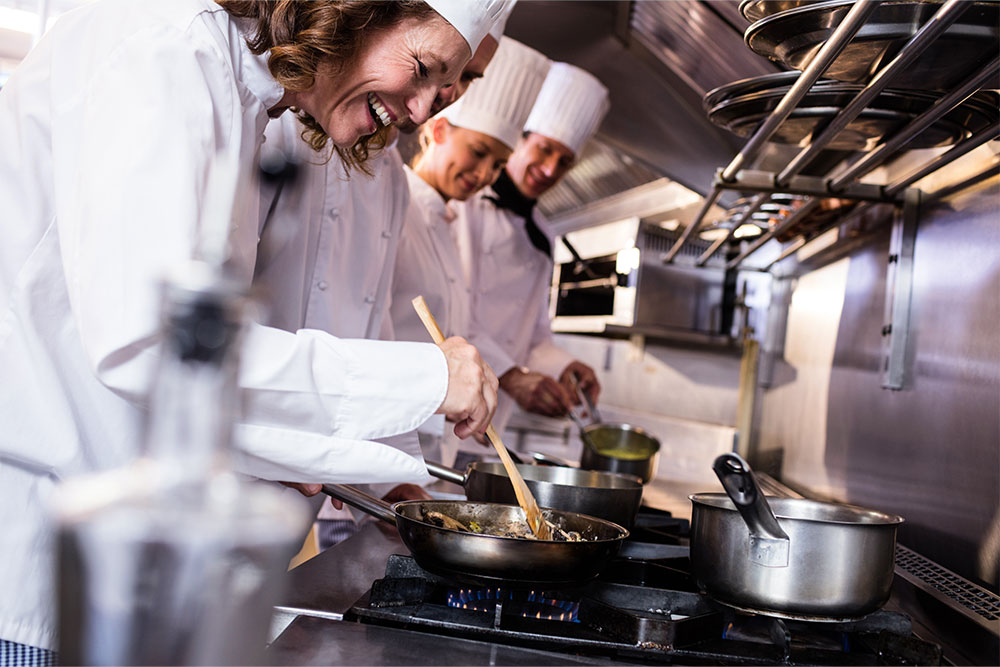
Is there a difference between a chef and a cook?
Yes. And you probably have an idea of what that difference is.
Picture a chef. You’re probably thinking of someone decked out in brilliant whites barking orders across a busy kitchen preparing sophisticated food for demanding customers.
Now, think of a cook. They’re probably much calmer and have traded in their whites for a practical but hardly eye-catching apron. And they’re likely focused on providing decent food in bulk, not a unique culinary experience.
These two images might be cliché, but they’re rooted in fact. In this guide, we look closer at where the typical ideas about chefs and cooks come from and how the roles actually differ.
The Difference Between a Chef and a Cook
Chefs generally don’t follow recipes, whereas cooks do. This is the key difference between a chef and a cook. Some argue that chefs are more skilled than cooks, often due to their more rigorous training.
There is some validity to this argument as chefs are usually more highly trained than cooks and are often expected to innovate or adapt dishes to meet their employer’s (or customer’s) culinary expectations.
It also takes skill to be a cook. Still, the specific qualities needed for the role differ as they rarely work in kitchens with high barriers to entry or the need to delight paying customers.
Training
The distinction between a cook and chef starts long before either steps foot into a kitchen, with different levels of training expected for each role. Chefs are usually the product of an extensive, formal education. In contrast, a cook’s skills often come from on-the-job training.
Food Hygiene Courses
Equip food workers with essential training for their role. Our online food hygiene courses provide an understanding of food safety, HACCP systems and cross-contamination. All courses award independently recognised certificates for proof of training.
Training for Chefs
You need some formal training before reaching the position of chef. Two training pathways open to aspiring chefs are completing an apprenticeship or a culinary degree.
Culinary degrees are considered by most industry professionals as essential for chefs. Depending on the specific programme, earning a degree can take two to four years.
Apprenticeship programmes vary, but all require aspiring chefs to complete hands-on training in a working kitchen environment.
In reality, most chefs would’ve completed some combination of the two. It takes a certain level of knowledge to tackle even the most basic tasks in a busy professional kitchen, so most apprentices have had some education before continuing their training in a working environment.
Similarly, while there are specialist cooking schools that can teach would-be chefs the fundamental skills they need, without time spent in a working kitchen, they’d lack the practical experience required to succeed in a professional role.
Training for Cooks
Training requirements are less extensive for cooks. You don’t need any training if you’re prepared to work your way up from an entry-level role.
For cooks, progression is its own form of training. Junior cooks learn on the job from their more experienced colleagues. But this is without the formality, organisation or purpose of chef training programmes, which are focused more on developing advanced cooking abilities than giving the trainee job-specific skills.
Responsibilities
At the most basic level, chefs and cooks share the same responsibility – to prepare food. However, chefs commonly have additional duties since they are more experienced and trained than most cooks.
Responsibilities of a Chef
Professional chefs usually spend most of their time preparing food. Still, they’ll likely have additional duties in and out of the kitchen, particularly if they’re in a more senior role (more on this later).
Regarding cooking, chefs generally specialise in one specific area, becoming experts in one type of food or cooking style.
Senior chefs also help direct their junior colleagues and keep the kitchen running smoothly by working in a supervisory capacity.
Chefs will also influence the menu and ingredients offered by their restaurant, often creating entirely new dishes that fit their establishment’s style or aesthetic.
A chef’s duties are in service of their crucial responsibility: create a memorable dining experience. They should serve unique dishes or innovations on a classic to customers paying for (and expecting) a certain level of quality.
Responsibilities of a Cook
Professional cooks usually only have responsibilities in the kitchen. After they’ve finished their shift, it’s rare for a cook to have additional duties, and their influence on the menu they prepare is also minimal.
This difference in decision-making power is one of the critical differences when exploring the role of a chef vs cook.
A cook usually follows an established recipe to fulfil a menu decided on by others. It’s not to say that cooks wouldn’t have the knowledge or skill to innovate or suggest new dishes, but a cook’s not expected to do so.
Some more senior cooks do supervise less-experienced colleagues but generally stick to their specific job roles.

Cooks are ultimately a little more practical. They often work in kitchens serving workplaces or schools, so their patrons don’t technically qualify as paying customers. It’s usually more important for cooks to serve decent food in large quantities than to create an unforgettable meal.
Roles
Both cooks and chefs have distinct job roles determining their specific responsibilities. Unsurprisingly, chef roles are more formally defined and arranged within a clear hierarchy.
Cooks still have levels of seniority with differing roles, but the hierarchy isn’t as structured.
Chefs – the Brigade de Cuisine
Chef roles are defined within the Brigade de Cuisine – a concept that originated in France (shocking, I know). The Brigade de Cuisine is a recognised framework for professional kitchens that organise chefs based on their experience and domain. The key roles are:
- Executive Chef – The executive chef sits at the top of the kitchen hierarchy, second only to the restaurant owner. It’s up to the executive chef to make decisions on staffing and managing the kitchen, often being responsible for multiple restaurants. It’s extremely rare for them to actually do any cooking
- Chef de Cuisine/Head Chef – The head chef is more focused on managing one specific kitchen and ensuring food is ready on time and to an acceptable standard. They’re also instrumental in designing menus and making purchasing decisions for ingredients
- Sous Chef/Deputy Chef – Sous chefs work closely with the head chef and assist them in their duties. They’ll also manage the kitchen if the head chef is absent
- Chef de Partie/Station Chef – This position covers many different roles depending on the chef’s expertise. A station chef focuses on one particular section, which means a professional kitchen will employ multiple station chefs simultaneously. It would take too long to list all the roles a station chef might hold, but they’ll generally focus on one type of food (meat, fish, vegetables, etc.) or cooking style (roasting, frying, grilling, etc.)
- Commis Chef/Junior Chef – Junior chefs work directly under a station chef, honing a particular craft. Junior chefs will either have recently completed training or be in some apprenticeship programme
Cooks – Whatever the Kitchen Needs
Cooks have defined job roles but are not as formally organised (or fancifully titled) as chefs. Key cook roles include:
- Line Cook – One of the more senior cooks. Before taking on this role, you need a few years experience working in kitchens. Line cooks manage a single cooking station
- Prep Cook – As the name suggests, this role involves preparing food. The prep cook cleans, chops and cuts up produce ready for the line cook. You need around a year of working in kitchens to take on the duties of a prep cook.
- Short-Order Cook – An entry-level position. Short-order cooks generally work in fast food restaurants or cafes where they must turn around multiple different meals quickly.
Fundamental Similarities
Working in a professional kitchen can be challenging, whatever the job role or setting. All food industry professionals need technical abilities, communication skills and a hefty dose of resilience.
Anyone in any capacity in food preparation needs to know how to keep kitchens safe and clean and protect patrons from foodborne illness or allergic reactions. All aspiring chefs and cooks should be trained in established food safety protocols, including properly handling known allergens.
Our online Food Allergen Training informs you of proven food safety management systems. It guides you through the guidelines for working with the 14 food allergens. Completing the course will help prepare you for your first day in the kitchen, giving you an understanding of standard practices in allergy safety and hygiene so you can hit the ground running.





















